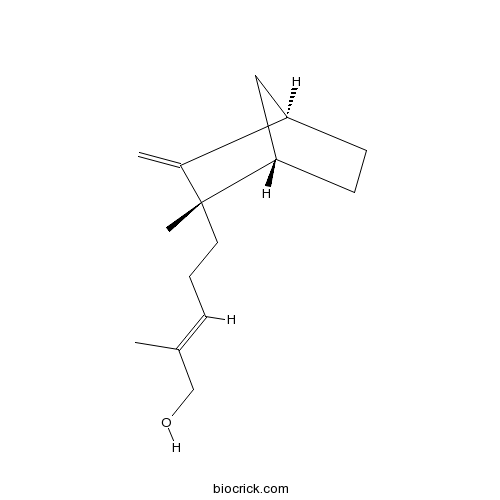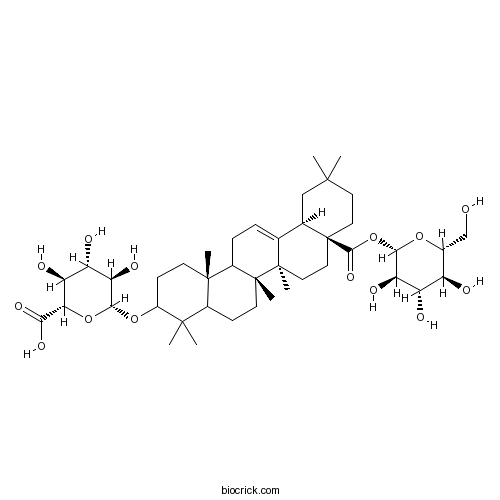Aralia taibaiensis
Aralia taibaiensis
1. The products in our compound library are selected from thousands of unique natural products; 2. It has the characteristics of diverse structure, diverse sources and wide coverage of activities; 3. Provide information on the activity of products from major journals, patents and research reports around the world, providing theoretical direction and research basis for further research and screening; 4. Free combination according to the type, source, target and disease of natural product; 5. The compound powder is placed in a covered tube and then discharged into a 10 x 10 cryostat; 6. Transport in ice pack or dry ice pack. Please store it at -20 °C as soon as possible after receiving the product, and use it as soon as possible after opening.
Natural products/compounds from Aralia taibaiensis
- Cat.No. Product Name CAS Number COA
-
BCN8352
Santalol11031-45-1
Instructions

-
BCN3432
Chikusetsusaponin IVa51415-02-2
Instructions

[Tissue distribution of araloside A in rats].[Pubmed: 29243440]
Araloside A is one of the main active ingredients of Aralia taibaiensis. In this study, HPLC-MS/MS analysis method of araloside A in the main organs of SD rats was established. At the same time, the content of araloside A in the main organs (heart, liver, spleen, lung, kidney, brain) after oral administration with araloside A (50 mg•kg⁻¹) were determined to explore the tissue distribution characteristics of araloside A in vivo. The results showed that the methodological study of araloside A in the main organs of SD rats met the requirements, araloside A distributed in heart, liver, spleen, lung, kidney and brain tissues reached peak at 1 h or 2 h after oral administration with 50 mg•kg-1.The distributions of araloside A at different time points after administration were distinct as follows: the content of araloside A at 20 min:liver>heart>spleen>lung>kidney>brain; the content of araloside A at 1 h: liver>spleen>kidney>lung>heart>brain; the content of araloside A at 2 h: liver>kidney>heart>spleen>lung>brain; the content of araloside A at 4 h: kidney>liver>spleen>heart>lung>brain; the content of araloside A at 8 h: spleen>heart>liver>kidney>lung>brain. Therefore, araloside A was mainly distributed in liver tissue, which had a certain correlation with the common use of Aralia taibaiensis in the treatment of hepatic disease. In addition, araloside A shows a low content but an obvious distribution in brain tissues, which indicates that the drug can pass through blood-brain barrier, and provides the basis for the study of araloside A in brain tissue.
Chikusetsu (CHI) triggers mitochondria-regulated apoptosis in human prostate cancer via reactive oxygen species (ROS) production.[Pubmed: 28391166]
The prostate cancer prognosis is still not fully understood. Chikusetsu saponin Iva (CHI), isolated from Aralia taibaiensis, shows anti-cancer and anti-inflammatory properties. Here, in our study, we attempted to explore the efficiency and the possible molecular mechanism by which CHI may suppress prostate cancer. CHI was found to inhibit prostate cancer cell proliferation and induce cell death without cytotoxicity in prostate normal cells. CHI resulted in intracellular reactive oxygen species (ROS) production, and induced apoptosis regulated by mitochondria in vitro studies. CHI-caused apoptosis was shown in both caspase-dependent and -independent manner, which released cyto-c, enhancing caspases expression and promoting apoptosis-inducing factors (AIF) as well as endonuclease G (Endo G) nuclear transfer, respectively. Moreover, in vivo study showed that prostate tumor was inhibited by CHI administration through apoptosis induction. Thus, the results illustrated that CHI might be an effective therapeutic strategy for prostate cancer treatment in future.
Chikusetsu saponin IVa confers cardioprotection via SIRT1/ERK1/2 and Homer1a pathway.[Pubmed: 26648253]
Hyperglycemia-induced reactive oxygen species (ROS) generation and Ca(2+) overload contribute to the development of diabetic cardiomyopathy. In this study, we aimed to study the protective effects of Chikusetsu saponin IVa (CHS) from Aralia taibaiensis against hyperglycemia-induced myocardial injuries. Treatment of H9c2 cells with high glucose (HG) for 24 h resulted in a loss of cell viability and increase of ROS, LDH and Ca(2+) levels, and also induced cell apoptosis, and those changes were all markedly reversed by the administration of CHS. In further studies, CHS dose-dependently increased the expression of Homer1a, ERK1/2 and SIRT1 in both H9c2 cells and rat primary cardiomyocytes. However, transfection of Homer1a-specific siRNA abolished the ability of CHS in controlling the ROS and Ca(2+) homeostasis. Moreover, specific SIRT1 inhibitors or siRNA significantly suppressed the enhanced phosphorylation of ERK1/2 and expression of Homer1a induced by CHS as well as its cytoprotective effect. CHS induced Homer1a expression was also suppressed by siERK1/2. Additionally, results in diabetic mice also showed that CHS protected myocardium from I/R-introduced apoptosis by activating the SIRT1/ERK1/2/Homer1a pathway. These results demonstrated that CHS protected against hyperglycemia-induced myocardial injury through SIRT1/ERK1/2 and Homer1a pathway in vivo and in vitro.
Total saponins from Aralia taibaiensis protect against myocardial ischemia/reperfusion injury through AMPK pathway.[Pubmed: 26498380]
It was previously shown that total saponins extracted from Aralia taibaiensis (sAT) have potent antioxidant activities for treating diabetes mellitus and attenuate d-galactose-induced aging. Since diabetes mellitus and aging are closely associated with cardiac dysfunction, particularly ischemic heart disease, sAT may have potential protective activity against myocardial ischemia/reperfusion injury (MI/RI). However, the anti-MI/RI effects of sAT have yet to be examined, and the possible molecular mechanisms remain to be determined. The present study was undertaken to investigate the anti-MI/RI activities of sAT and to elucidate the mechanisms underlying these effects in rats using TUNEL and Hoechst 33258 staining. The results confirmed the cardioprotective effects in vivo and elucidated the potential molecular mechanisms of sAT in vitro. Pretreatment with sAT significantly reduced infarct size, decreased the levels of lactate dehydrogenase and creatine kinase in the serum and blocked apoptosis. In addition, sAT inhibited A/R-induced apoptosis by decreasing DNA strand breaks, caspase-3 activity and cytochrome c release in H9c2 cells. Furthermore, sAT markedly increased the phosphorylation of AMP-activated protein kinase (AMPK) and acetyl CoA carboxylase and elevated the Bcl2/Bcl-2-associated X protein ratio. These effects were blocked by compound C. The results suggested that sAT pretreatment exerts protective effects on myocardial cells in vitro and in vivo against MI/RI-induced apoptosis by activating AMPK pathway.
Aralia taibaiensis Protects Cardiac Myocytes against High Glucose-Induced Oxidative Stress and Apoptosis.[Pubmed: 26446201]
Patients with type 2 diabetes have increased cardiovascular disease risk compared with those without diabetes. Hyperglycemia can induce reactive oxygen species (ROS) generation, which contributes to the development of diabetic cardiomyopathy. Our previous study has demonstrated that the total saponins of Aralia taibaiensis (sAT), a frequently-used antidiabetic medicine in traditional Chinese medicine (TCM), can scavenge free radicals in vitro and have good anti-oxidant ability on lipid peroxidation of rat liver microsomes. This work was designed to investigate whether sAT could protect the heart while it was used in the treatment of diabetes. Oxidative stress was induced in H9c2 cells by high glucose (33 mM) and glucose oxidase (15 mU, G/GO) and the protective effects of sAT were evaluated. Treatment of H9c2 cells with G/GO resulted in an increase in cell death, intracellular ROS level and cell oxidative injury, which were markedly reduced by sAT treatment. Further study revealed that sAT induced the nuclear translocation of Nrf2 and expression of its downstream targets. Moreover, Nrf2 siRNA markedly abolished the cytoprotective effects of sAT. sAT exerted cytoprotective effects against oxidative stress induced by hyperglycemia and the cardioprotective effects of sAT might be through the Nrf2/ARE pathway. Thus, sAT might be a promising candidate for the treatment of diabetic cardiomyopathy.
Insulinotropic effect of Chikusetsu saponin IVa in diabetic rats and pancreatic β-cells.[Pubmed: 25701750]
As a well-known traditional Chinese medicine the root bark of Aralia taibaiensis has traditionally been used as the medicine considered alleviating several disorders including diabetes mellitus (DM). Chikusetsu saponin IVa (CHS) has been defined as a major active ingredient of triterpenoid saponins extracted from Aralia taibaiensis. The scientific evidence of anti-diabetic effect for CHS remains unknown and the purpose of our study was to study its hypoglycemic and insulin secretagogue activities.
Chikusetsu saponin IVa regulates glucose uptake and fatty acid oxidation: implications in antihyperglycemic and hypolipidemic effects.[Pubmed: 25677570]
The aim of this study is to investigate antidiabetic effects and molecular mechanisms of the chemical Chikusetsu saponin IVa (CHS) that isolated from root bark of Aralia taibaiensis, which has multiple pharmacological activity, such as relieving rheumatism, promoting blood circulation to arrest pain and antidiabetic action.
Saponins from Aralia taibaiensis attenuate D-galactose-induced aging in rats by activating FOXO3a and Nrf2 pathways.[Pubmed: 24669284]
Reactive oxygen species (ROS) are closely related to the aging process. In our previous studies, we found that the saponins from Aralia taibaiensis have potent antioxidant activity, suggesting the potential protective activity on the aging. However, the protective effect of the saponins and the possible underlying molecular mechanism remain unknown. In the present study, we employed a D-galactose-induced aging rat model to investigate the protective effect of the saponins. We found that D-galactose treatment induced obvious aging-related changes such as the decreased thymus and spleen coefficients, the increased advanced glycation end products (AGEs) level, senescence-associated β-galactosidase (SAβ-gal) activity, and malondialdehyde (MDA) level. Further results showed that Forkhead box O3a (FOXO3a), nuclear factor-erythroid 2-related factor 2 (Nrf2), and their targeted antioxidants such as superoxide dismutase 2 (SOD2), catalase (CAT), glutathione reductase (GR), glutathione (GSH), glutamate-cysteine ligase (GCL), and heme oxygenase 1 (HO-1) were all inhibited in the aging rats induced by D-galactose treatment. Saponins supplementation showed effective protection on these changes. These results demonstrate that saponins from Aralia taibaiensis attenuate the D-galactose-induced rat aging. By activating FOXO3a and Nrf2 pathways, saponins increase their downstream multiple antioxidants expression and function, at least in part contributing to the protection on the D-galactose-induced aging in rats.
Antihyperglycemic, hypolipidemic and antioxidant activities of total saponins extracted from Aralia taibaiensis in experimental type 2 diabetic rats.[Pubmed: 24524879]
As a well-known traditional Chinese medicine the root bark of Aralia taibaiensis has multiple pharmacological activities, including relieving rheumatism, promoting blood circulation to arrest pain, inducing diuresis to reduce edema, and antidiabetic action. It has long been used as a folk medicine for the treatment of traumatic injury, rheumatic arthralgia, nephritis, edema, hepatitis and diabetes mellitus in China.


